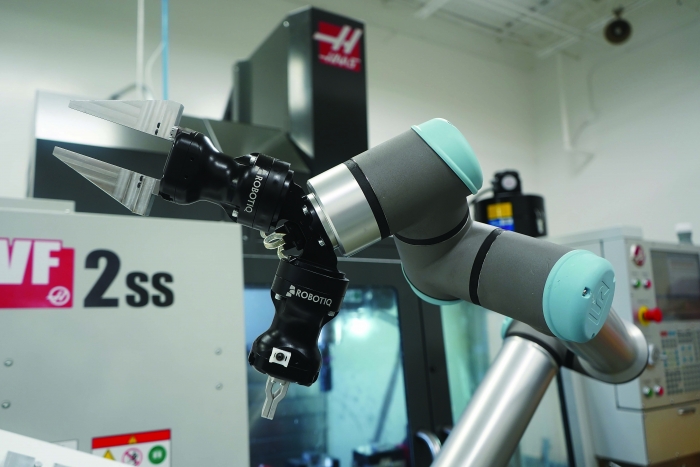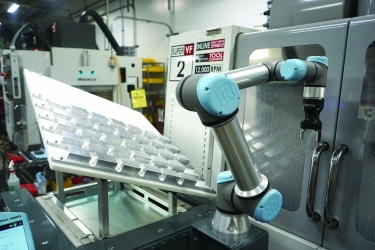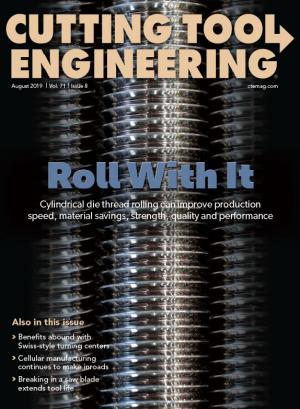Fusion OEM specializes in machining aluminum, steel and plastic parts for customers in the Midwest. Based in Burr Ridge, Illinois, its high-mix, low-volume factory operates 14 Haas CNC machines.
Head Machinist Davin Erickson has followed top CNC machining channels on Instagram and YouTube for years. Always looking for inspiration from other machinists, he was impressed when he saw a robot operating a machine without caging. Despite the common fear that robots steal jobs, he and some co-workers suggested to management that the use of collaborative robots, or cobots, be considered.
“We then began to see these collaborative robots everywhere on social media and at trade shows,” Erickson said. “We tried to convince our CEO that this would be great for our factory. It took a few tries. But since it was very difficult to find good human help around here, we finally welcomed our first robot in the summer of 2018.”

A Robotiq Hand-E adaptive gripper with a dual setup that’s mounted on a Universal Robots cobot tends to a Haas CNC machine at Fusion OEM. Image courtesy of Robotiq
Empowering people is what made CEO Craig Zoberis decide to proceed with Universal Robots USA Inc., Ann Arbor, Michigan, and Robotiq Inc., Lévis, Quebec, as partners for his cobots project.
“I read this Lean Robotics book written by Samuel Bouchard, which taught me many things, but the most important is that robots help fulfill human potential,” Zoberis said. “So instead of having our staff loading and unloading machines every 10 minutes, they can focus on machine programming and any other value-added tasks.”
Fusion OEM deployed four cobots in less than a year. The automated application starts with parts—presented on a nesting system—being picked up by Robotiq’s Hand-E adaptive gripper (single or dual setup), which is mounted on a Universal Robots UR5e or UR10e cobot depending on a machine’s requirements. The gripper then opens the door and carefully inserts the part into the chuck using Robotiq’s Force Copilot software, which is UR+ certified, meaning that it interfaces seamlessly with Universal Robots’ cobots. The robot then closes the door and signals to the machine to start the cycle.
The gripper, which is for precise insertion of parts and has customizable fingertips, was a perfect match for Fusion OEM’s machine-tending operations.
“We’re able to connect the grippers directly to the robot’s wrist, get feedback on position and force and know if there’s a part where there should be one and if it’s the right part,” said R&D Manager Stephen Milchuck, who needed only a few minutes to begin operating Hand-E with its software interface.
Inserting a part into a machine chuck requires many programming steps, especially when using a robot’s force control for better accuracy and repeatability.
“The program was getting pretty big because we were trying to have the robot accomplish all movements through different axes to place the part,” said Engineering Manager Jacob Miller. “Then, by adding one or two lines of code through Force Copilot, we let the software generate all the part positioning in a much faster and simpler way.”
The new application quickly proved its value. Chief Operating Officer Ken Chess started gathering data on the company’s most frequently recurring order.
“We often do lots of around 500 parts for this customer,” he said. “Before the robots arrived, it would take almost six days to deliver. But now with the cobots running overnight, it takes three days, and our defect rate has gone down since robots make fewer mistakes than even the best machinists out there.”
Fusion OEM relies on Robotiq’s Insights monitoring software to send text and email alerts to employees if production stops for any reason. If an employee is off-site, he or she even can log in remotely to solve a problem.
“We also get predictive signals that tell us when a raw part supply is almost empty,” Chess said. “With all these tools helping us maximize runtime, we get a much better margin on the job.”
What started as an exploratory project rapidly showed its reliability.

A Universal Robots cobot with a Robotiq adaptive gripper prepares to open a machine door.
“We monitor the productivity of each robot with Insights data,” Chess said. “We can spot areas of improvements for those robots and plan accordingly for future robot deployment.”
He estimates that running a job on a given machine with a robot is four times cheaper than operating manually.
The addition of robots has helped employees in different ways. Machinist Brian Wroblesky now spends more time on value-added tasks, such as programming machines without having to load them.
“There’s more consistency in the loading and unloading of the parts,” he said. “It’s taken away some of the human error.”
Ease of use is another major plus for employees. Production Supervisor Chris Wenzel had seen numerous industrial robots and was impressed by the offerings from Robotiq and Universal Robots.
“The programming, the interface—everything is easier,” he said. “Now we talk about each program in terms of minutes rather than hours.”
The humans and robots get along pretty well. For Jenny Kim, a machinist, the robots are just like any other equipment inside the shop.
“I call them brobots because they’re like your brothers,” she said. “You have to treat the machines kindly. Respect them, and they respect you back.”
Fusion OEM’s goal is to have robots tending all 14 CNC machines by early 2020. In the next year, the company hopes to double production capacity, increase machine uptime and continue maximizing human potential.
For more information about how Fusion OEM boosted productivity with collaborative robots, view a video presentation at www.ctemag.com by scanning the QR code on your smartphone or entering this URL on your web browser: cteplus.delivr.com/2pck7
Contact Details
Contact Details
Contact Details
Related Glossary Terms
- arbor
arbor
Shaft used for rotary support in machining applications. In grinding, the spindle for mounting the wheel; in milling and other cutting operations, the shaft for mounting the cutter.
- burr
burr
Stringy portions of material formed on workpiece edges during machining. Often sharp. Can be removed with hand files, abrasive wheels or belts, wire wheels, abrasive-fiber brushes, waterjet equipment or other methods.
- chuck
chuck
Workholding device that affixes to a mill, lathe or drill-press spindle. It holds a tool or workpiece by one end, allowing it to be rotated. May also be fitted to the machine table to hold a workpiece. Two or more adjustable jaws actually hold the tool or part. May be actuated manually, pneumatically, hydraulically or electrically. See collet.
- computer numerical control ( CNC)
computer numerical control ( CNC)
Microprocessor-based controller dedicated to a machine tool that permits the creation or modification of parts. Programmed numerical control activates the machine’s servos and spindle drives and controls the various machining operations. See DNC, direct numerical control; NC, numerical control.
- robotics
robotics
Discipline involving self-actuating and self-operating devices. Robots frequently imitate human capabilities, including the ability to manipulate physical objects while evaluating and reacting appropriately to various stimuli. See industrial robot; robot.
- sawing machine ( saw)
sawing machine ( saw)
Machine designed to use a serrated-tooth blade to cut metal or other material. Comes in a wide variety of styles but takes one of four basic forms: hacksaw (a simple, rugged machine that uses a reciprocating motion to part metal or other material); cold or circular saw (powers a circular blade that cuts structural materials); bandsaw (runs an endless band; the two basic types are cutoff and contour band machines, which cut intricate contours and shapes); and abrasive cutoff saw (similar in appearance to the cold saw, but uses an abrasive disc that rotates at high speeds rather than a blade with serrated teeth).
- web
web
On a rotating tool, the portion of the tool body that joins the lands. Web is thicker at the shank end, relative to the point end, providing maximum torsional strength.
End User:
Fusion OEM
866-952-9020
www.fusionoem.com
Solution Providers
Robotiq Inc.
888-966-8993
www.robotiq.com
Universal Robots USA Inc.
844-462-6268
www.universal-robots.com
Challenge:
Cost-effectively increase productivity.
Solution:
Use collaborative robots.



